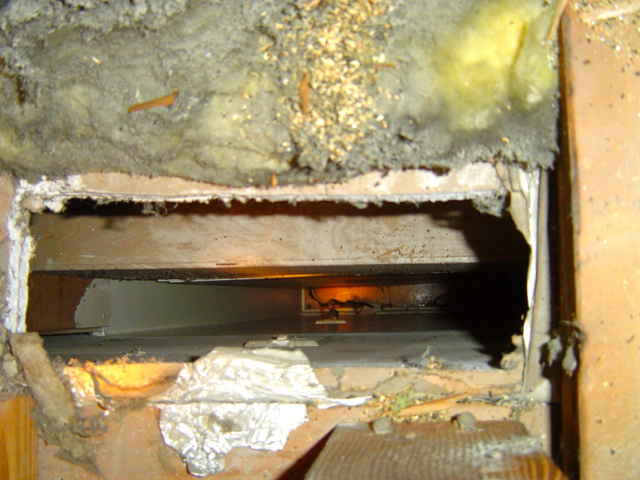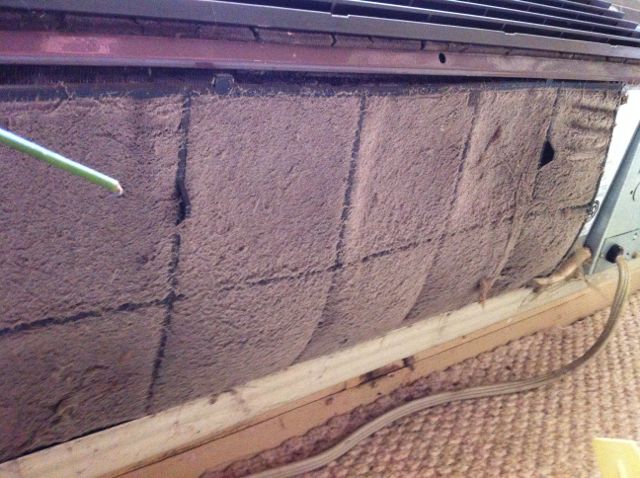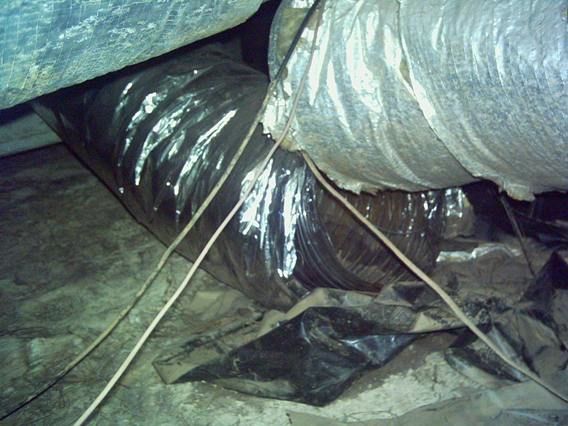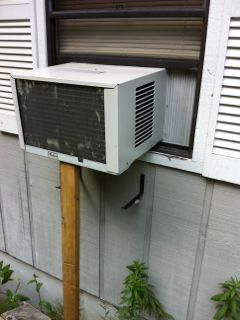9 Uncommon Tips for Keeping Cool with a Struggling Air Conditioner

We went through a record-setting heat wave recently in the US. Here in Atlanta, we set an all-time record of 106° F. Homes with properly-sized air conditioners—yeah, yeah, I know they’re few and far between—are sized for our design temperature of 92° F and probably didn’t stay so cool. I’m sure quite a few homes with air conditioners that appear to be significantly oversized didn’t stay cool enough either. How’d your home do? Did you have trouble keeping cool with a struggling air conditioner?
Every summer you can find lots and lots of tips on how to save energy and keep cool at home: Wear cooler clothes, use your ceiling fans, keep the sun out, go to a movie, get your air conditioner serviced, caulk your windows… Alex Wilson wrote up several cooling tips like this at Green Building Advisor a few weeks ago. I’ll mention a few common tips in this article, but I’m also going to discuss some that you may never have seen in an article like this before.
Before we get into the actual tips, though, it may be helpful to remember how the whole cooling thing works. Earlier this year, I heard a great expression on the radio: Your air conditioner is the faucet; the building envelope of your home is the cup. If you have a leaky cup, your air conditioner has to work harder. If your AC is already doing all it can, you may need to take a look at your building envelope. Also, to return to the metaphor, a leak in your water pipe may make it impossible to fill up the cup, even it’s not leaking much.
Here are three questions to ask as you try to keep cool with an air conditioner that struggles on those really hot days:
- What can I do to reduce the amount of heat getting in?
- What can I do to make my air conditioner more effective?
- What else can I do to keep cool?
Let’s dive into the tips now. I’m focusing here on existing homes. Whether it’s a brand new home you just moved into or a hundred years old, the home is already there, so some design options are off the table.
Tips for keeping heat out
1. Keep the sun out. Windows can be the largest contributors to your heat gain. When the sun shines directly into the house, it usually brings a lot of heat, too, unless you have really good windows (with low solar heat gain coefficients). Solar screens on the outside of the window are great for keeping heat out. You might also consider some temporary shading for the east- and west-facing windows on those superhot days.
2. Seal the strange air leaks. Most of the standard energy-saving advice tells you to caulk your windows and weatherstrip your doors. The problem with that is you’re ignoring some of the much bigger leaks, like, say, crawl space vents that open into conditioned space or a hole in the kitchen ceiling that acts as a refrigerator vent (photo at right). Look around in your attic, crawl space, or basement, and you’ll find the worst offenders.

3. Reduce the surface temperatures. Some parts of your home may be hotter than others. For example, you may have a bonus room that’s rarely comfortable. Attic kneewalls with ineffective insulation are often the culprit there. Get the insulation in the cavities and put sheathing on the attic side of the kneewalls. Naked people need building science in summer as well as winter.
Tips for helping your air conditioner
4. Change your filter. Most people let them get too dirty, and this is one of the most common reasons for poor performance in air conditioners. A dirty filter adds resistance and reduces air flow. Go ahead and check it now. I’ll wait till you get back.

5. Improve air flow. In addition to the air filter, your AC may have other types of air flow problems. If the evaporator coil is dirty, not enough air moves across it and your home doesn’t cool off as well as it should. If the condenser coil is dirty, it won’t dump enough heat to the outside. If your condenser coil is crowded with vegetation or other obstacles, clear it out. You can trim the bushes yourself, but you should probably call a pro to clean the coils.
6. Look for disconnected ducts. If your ducts are outside of the conditioned space in your home, check to see if anything has come loose. Fixing a supply duct that’s sending all its cool air to the attic or crawl space (as shown below) can have an immediate impact on your comfort. This problem is more common than you may think.

Other tips for keeping cool
7. Use fans. OK, I know this one’s not uncommon, but if your air conditioner is doing all it can but your home still isn’t quite cool enough on those really hot days, moving the air over your skin may be just what you need to stay comfortable. Remember, though, that fans don’t cool the air; they cool you. Turn off ones that are in empty rooms because they’re using energy and adding more heat to your home. Need to buy a new ceiling fan? They now come with energy efficiency labels showing how energy efficient they are. Here are 7 other things you may not know about ceiling fans.
8. Use a window air conditioner or a portable AC. If you’ve done everything above and your home is still uncomfortably hot, installing a window unit or bringing in a portable AC could give you just enough extra cooling to help you make it through the heat wave. I know. I know. They’re ugly and noisy and may be against the rules where you live. They use more power, which adds to the strain on the electricity grid, and may contribute more to global warming. Still, if you’ve got an energy efficient home with a right-sized air conditioner, this could be the best way to handle those heat waves when temperatures go well above what your central air conditioner was designed for. It’s a much better solution than installing an oversized system just so you have enough capacity to handle the extreme heat events. A more expensive and permanent alternative to the window unit would be a ductless mini-split heat pump.
you’ve done everything above and your home is still uncomfortably hot, installing a window unit or bringing in a portable AC could give you just enough extra cooling to help you make it through the heat wave. I know. I know. They’re ugly and noisy and may be against the rules where you live. They use more power, which adds to the strain on the electricity grid, and may contribute more to global warming. Still, if you’ve got an energy efficient home with a right-sized air conditioner, this could be the best way to handle those heat waves when temperatures go well above what your central air conditioner was designed for. It’s a much better solution than installing an oversized system just so you have enough capacity to handle the extreme heat events. A more expensive and permanent alternative to the window unit would be a ductless mini-split heat pump.
9. Turn off your powered attic ventilators. If you have powered attic ventilators in the attic, have them disconnected so they don’t run. They may well be robbing cool air from your home, and they’re addressing the wrong problem anyway.
Bonus
Get a home energy assessment. Trained home energy auditors can find the problems I listed above and more and recommend solutions. They also have equipment to measure how leaky your ducts are, for example, as well as the surface temperatures of your floors, walls, and ceilings. Check out my advice for choosing a home energy auditor.
If your AC can’t keep up when it’s hotter than normal outside, use the advice above to help get through the crisis. Your home will be more comfortable and efficient for it even when the temperatures return to normal.
Allison Bailes of Atlanta, Georgia, is a speaker, writer, building science consultant, and founder of Energy Vanguard. He is also the author of the Energy Vanguard Blog and is writing a book. You can follow him on Twitter at @EnergyVanguard.
Related Articles
Your HVAC System Is the Faucet; The Building Envelope Is the Cup
How Energy Efficient Is Your Ceiling Fan?
Does Your Bonus Room Need More Air Conditioning?
How to Sheathe an Attic Kneewall — And How Not to
Naked People Need Building Science
Air Barrier Sleuthing – Building Envelope Lessons for DET Verifiers
This Post Has 30 Comments
Comments are closed.

There is one aspect of #6 (a
There is one aspect of #6 (a disconnected duct) which I see as highly important, and seldom mentioned. When you systematically blow maybe 100 CFM outside the house envelope, that is nearly the same as blowing 100 CFM of hot-humid outside air in! Is that not worth mentioning, with its effect on house humidity too?
An aspect of #3 (reduce surface temperatures): Is there a reason you don’t mention radiant barrier writing from hot-humid Atlanta? The savings are moderate but proven in the right climate. I have read that the majority of savings comes from reducing duct losses. Even if you have lots of attic floor insulation, many HVAC pros say it is wrong to bury ducts in insulation. Their reasoning is attic air likely has a dew point in the 75-80F range, and condensation on the outer surface of the duct would be harmful.
M. Johnson
M. Johnson: Yes, that’s a good point that duct leakage can create a feedback loop with more infiltration if the leakage is unbalanced. I was trying to keep my tip explanations simple so I didn’t discuss that.
I considered including radiant barriers in my discussion but installing one is a bigger operation than the rest of my tips, and, as you mention, their effect can be moderate. The best scenario for adding a radiant barrier is if you’re in a hot climate and have ducts in the attic.
You just reminded me of a tip that I’d meant to add so I’ll put it in the article above as a Bonus.
In Extream heat of the day
In Extream heat of the day you can also put a sprinkler on the condensing unit to help with the heat transfer.
Jamie C.:
Jamie C.: That’s another good one. You have to be careful about mineral deposits building up, so I wouldn’t do that one too much. I’m also not sure how much it helps, but Southface was doing that for a while with their EcoOffice condensing units.
Question: Are attic
Question: Are attic ventilators OK if the upper story is not air conditioned? Intuitively, the cooler the attic, the less heat transfers to the top floor. Correct?
Don W.: It
Don W.: It’s gotten quite long now with nearly 60 comments as of today, but if you read the article I wrote about Power Attic Ventilators (PAV) and the comments, you find lots of info about that issue.
Here’s my summary:
1. If you have any atmospheric combustion appliances in the house, especially natural draft water heaters, don’t use a PAV.
2. If your ceiling isn’t air-sealed very well, the PAV will steal cool air from your home.
3. If your ceiling is air-sealed and insulated properly, then you don’t need a PAV.
Here’s a direct link to the article:
Don’t Let Your Attic Suck – Power Attic Ventilators Are a Bad Idea
My previous home in Charlotte
My previous home in Charlotte had a right-sized AC (2 tons for 3100 ft2). Actually, it was oversized, but a 1.5 ton would definitely have fallen short at the outdoor design temp of 91. A year after I sold the house, Charlotte experienced several consecutive days of 104F. I contacted the new owner and he said the house never reached 80F. He was happy, since I had educated him about all the downsides of oversizing when he bought the house.
@Jamie, mister tubes work best for water-cooling the condenser.
@Don, in addition to what Allison said regarding PAV’s… If the upstairs isn’t air conditioned, then you’re better off using a window fan. While the PAV may lower the attic temperature, especially higher up at the ridge, the impact on the ceiling loads isn’t worth the energy consumed by the fan (aside from the larger impact of sucking conditioned air out of conditioned space, as Allison mentioned). The lifecycle cost of solar powered PAV’s is even worse.
Any recommendations / tips
Any recommendations / tips /caveats for solar screens? I’m considering retrofitting Pfifer solar screen for E and S facing windows, where we have almost no shading. Good for solar PV, bad for solar heat gain. 🙂 (Unfortunately I have half screens so would need to order some full-length frames to make it worthwhile I think) Assuming equal shading (or lack thereof) is E/W or S more critical over the course of the day?
Hi Eric, I installed Pfifer
Hi Eric, I installed Pfifer solar screens on my master bedroom. As you know, I live in southern AZ. My bedroom faces south with no o/h protection. My system isn’t zoned, and I was having to overcool my house at night to get the bedroom comfortable, even with blinds shut all summer. Those solar screens sure did the trick.
Like yours, my windows had half-screens (horizontal sliders and single-hung, all vinyl). I removed factory screens and installed the solar screens on the exterior using single-screw turn-tabs directly into the outer frame.
West is obviously more critical than south for bedrooms, but south was bad enough for me. East, no so much. Interior blinds seem to do just fine.
A couple of tips: If you care about view and ventilation, go with the SunTex 80 fabric. Several dealers warned me that the SunTex 90 fabric blocks significantly more light and air. I also recommend contacting the factory for a list of local fabricators. I called several and price range was about 2:1 if I recall. I ended up providing measurements to the dealer, a glass company, and picked up the screens, saving delivery and install charges. As I recall, I paid around $3.50/ft2 (2007).
Hey Alison,
Hey Alison,
Thanks for your post.
On old Houses, what does “properly-sized air conditioners “ mean?
The idea that you can add multiple guesses and somehow reach the “right answer” is a bit silly. We don’t know any of the values and simply doubling your outside design temp from 92 to 106 will add a ton to our loads. Without expensive testing we have no clue how bad our leakage rates are on either the house or the ducts, we’re swaging the insulation values, and guessing at every input in our dumb-ed down “calculation”, all to try and determine a condition that will occur less than 1% of the time, A parlor act, nothing more.
Of course, everyone learns quickly how to game the models, work them backwards so their “calculations” come out to what they want. Then
Everyone gets to be right and smart. What a business, You gotta love it.
Keep em coming,
pj
@PJ: You have to guess at
@PJ: You have to guess at certain things if you want to do a heat load (Manual J) model on an older house. Of course. But I challenge people to find any better sizing methods.
On an existing house you have the advantage of being able to measure run times of the installed AC. This reduces guesswork. You probably would agree it is sized correctly when the AC experiences seriously long run times during hot days.
On my own 1989 house, I tried this method and found it mapped very closely to the Manual J calculations. But if you have an AC tonnage in mind and alter assumptions to work back to your answer, that is simply intellectually dishonest.
PAV’s can be appropriate for
PAV’s can be appropriate for some unique homes/circumstances, but in general I prefer to avoid them.
Ridge vents that builders push so hard is what I’m aiming my guns at, they simple DO NOT WORK as advertised. http://www.youtube.com/watch?v=SyIw2GTiKvQ
“You have to guess
“You have to guess at certain things if you want to do a heat load (Manual J) model on an older house. Of course.”
“But if you have an AC tonnage in mind and alter assumptions to work back to your answer, that is simply intellectually dishonest.”
Alison,
We agree. It is dishonest. It is an act. performance art!
You have to guess at every input and you really don’t know what temperature differences to expect anymore either. You make guesses that give you the numbers you like and since know one
knows the answer, you get to be right regardless. Everyone gets to be right, even with different answers.
But it is nothing more than a dog a pony show and no better than just using your experience, but it is ,as you say “dishonest”.
You may recall an article you once wrote talking about how you looked for over 1000ft/ton on new build. Sounds like starting with an answer to me. You are in good company, I have never met a contractor or anyone else for that matter who does not back into the loads they like on retrofits.
I have also taught guys how to give utilities and inspectors the metics they want, just tell me what you want and it is easy to deliver.
We are all dishonest!
As for your methodology, it it by far the simplest, most dumb-ed down
Approach to looking at loads and specifically fails to show they are constantly changing over time. I assume time had to be removed from the model to make It easy for us 4th grade math students. You may want to look into this a bit further.
A couple of problems with
A couple of problems with Manual J:
1: It assumes ALL loads are present at times of peak demand. Homeowners CAN use common sense and not run the dryer when it’s 100+ outside, or not run a fireplace when it’s 10 degrees.
2: Thermal storage isn’t accounted for. Having a masonry exterior distributes the peak load over a longer period of time. Smaller peak, more hours.
3: Solar position isn’t accounted for properly. The sun isn’t even shining on the north/east side of the house during the time of peak load, yet manual J accounts for it. 80% of the heat gain will be from the west during peak time of day.
4: No allowance for roof color/ventilation. Attic temperatures make a huge difference in heat gain. A well ventilated attic with white shingles can have a 1 ton less cooling load vs. a black roof with no attic ventilation.
5: No allowance for ductwork location. Ductwork located in unconditioned space has tremendous heat gain that’s not accounted for in manual J.
Unfortunately we don’t have anything better unless system run times were monitored before replacement and equipment was operating at rated capacity. This is rarely done in the real world…
I love building science fight
I love building science fight club!
#1 I agree PAVs suck! There is a neighborhood near me where 1500ft2attics have 2 and sometimes 3 or 4 of them, apperarantly a fly by night roofer sold them like crazy after the last hail storm and now all these people have moisture problems because of the negative pressure on the houses.
# 2 Ridge vents are pitiful especially with vaulted ceilings with R-19 fiberglass stapled in 2×8 rafters.
# 3 Blower door and duct blaster tests are not expensive
# 4 experience + manual J = good HVAC design for older homes . One is not much good without the other.
@Bob, re: your list of MJ
@Bob, re: your list of MJ problems… You clearly don’t know what you’re talking about.
pj: Not
pj: Not only are you confused about Manual J, you seem to be confused about whom you’re responding to as well. Again, we don’t agree on much of anything, so please don’t say we do. For example, when you say, “You have to guess at every input,” that just shows either how little you know or how completely you’ve let your anti-Manual J bias cloud your thinking.
Ok
&
Ok
We have to guess at ACH, duct losses,insulation values, indoor design conditions, etc. These values all have wide tolerances.
20 guys will get 21 loads yet they all get to be right!
You have to love a “science” where different guesses always add up to the right answer.
Them we get to criticize the guy who only made 1 guess.
Having taught over 7000 companies to do this proceedure I think I might know a bit about this.
Find me one guy who does not work it backwards on old houses and I will eat my hat.
We do agree, it is dishonest.
But it makes for good theater.
Thanks,
P
pj: Your
pj: Your nonsense does get tiresome. You seem to be stubbornly unreceptive to reality for some reason.
1. Blower Doors and duct testers give you the infiltration & duct leakage.
2. Inspections can determine insulation values.
3. You seem unable to grasp the distinction between uncertainty and inaccuracy.
Finally, we do NOT agree about much of anything as far as I can tell. Nowhere did I ever say that doing load calculations was dishonest. You also have misinterpreted my earlier article about how I use the 1000 sf/ton rule of thumb.
Hi Alison,
Hi Alison,
Reality?
I have never met an HVAC company in my entire life that does a Blower Door or duct test prior to doing a load calculation, ever. There is no way the HVAC cost structure can absorb this, and it simply does not happen.
What you describe is not reality.Realty is gaming the model to confirm your bias and sell a system.Please try to find s single contractor who does not do this.
I would love to join this world you speak of, could you please share some of what ever it is is you are smoking.
have fun at camp,
p
“Of course. But I
“Of course. But I challenge people to find any better sizing methods.”
M Johnson – I like David Butler’s truing method, measuring run time of equipment at design.
I like Phil’s SatJ calculator truing method, back into load by truing consumption.
I like thoroughly interviewing the homeowner about how things work “on the ground”, and understanding if they are implementing crazy tactics.
I like not counting on a single method for sizing, because sometimes the other methods call attention to weakness in one approach or another.
WRT to AC above load. If it’s not keeping up, drive the house to the lowest comfortable thermostat setting overnight to drive heat out of the houses mass.
Alison,
Alison,
I am sorry to be the one to let you know all US HVAC guys back into the loads we want by gaming our computers, I thought you would have known that.
Also, there is no Santa Claus.
pj
Here’s one I’ve never heard
Here’s one I’ve never heard mentioned in building science circles: Water Your Roof!
I read a book called “How to Really Save Money and Energy in Cooling Your Home” by George S. Barton
Put sprinklers on top of your roof to spray at set intervals a fine mist, not bulk water, and as the water evaporates it cools the roof. Is this legitimate?
http://www.KnowledgePublications.com/978-1-60322-005-7_detail_page.htm
p
&
p
if you have to make so many assumptions to manipulate the manual j..why bother?
leave it for those of us who
inspect existing homes for input values, test the house for air and duct leakage and know how to correctly size hvac.
plenty of work for the 500 sq ft per ton guys. when homeowner keeps paying for more expensive equipment and higher utility costs who do they call?
problem solvers, not parts changers.
those who can do.
those who use wag rule of thumb sizing keep us in
business.
good article Alison.
your thinking goes right along with what I’ve learned in my 12+ years in the efficiency business.
Thanks Debbie, <
Thanks Debbie,
I am sorry, I though we were supposed to be talking about “reality”.
Try this, open your phone book (or Google Air conditioner) and call the first 10,000 HVAC contractors listed to come out to your home for a quote to replace your HVAC system.
Notice, around 9,500 will do no load calculation, 500 will enter guesses into their computer and confirm they were right, and the number of folks using a blower door or any other test gadget will be equal to the number who arrive riding Unicorns.
Where is this fantasy world where the contractor on HVAC replacements absorbs all this testing cost? There are over 70,000 AC companies in the US. Please find me one that does this testing on a replacement quote prior to a check.
As you stated,
“Those that can do”, those that use Blower Doors, need subsidies!
P
my reality is that I have
my reality is that I have both blower door and pressure pans for duct leakage testing.
have happily been doing this work for 12+ years.
don’t work for utility
not subsidised by utility.
can’t fix all of them, but I sure can fix the ones I’m hired to fix.
oh and if they need a load calc, duct sizing or duct design..got that covered too.
if you see a need, you educate yourself to fill it.
and you charge based on your level of experience & education.
cheaper energy raters..you bet. but you get what you pay for. or don’t pay for.
if you’ve gotta pull numbers out of your trick bag..& lie to the homeowner..thats your gig.
not mine.
you don’t speak for all of us.
that is reality.
This would turn the
This would turn the construction world upside down, but one crazy idea would be for HVAC (yes, V included) to be designed, the structure built under those assumptions and tested, and only after that HVAC specified. Like I said, it would turn a lot of building processes upside down.
Thank you so much for the
Thank you so much for the excellent tips! That would be really helpful for me and my customers!
I’ll have to say that many of my clients really let the filter get too dirty! That is so wrong! The filters should be cleaned at least once per month! That’s the thing I keep telling them, but they always forget!
So my advice to all of you is to change or clean (depends on your AC) your filter!
I’ll try to think of tips to help more people!
Hi there! I have been reading
Hi there! I have been reading about how to maintain your AC and I have found some interesting tips! One of them is that we have to remove debris from outside unit! Everybody knows that the most central air conditioning systems today have an outdoor component and an indoor component. The outdoor component helps keep your property cool by removing hot air and expelling it outside. If there are debris, like leaves or grass clippings, clogging up the condenser unit, the air conditioner’s productivity could be compromised. We have to make sure to regularly clean the area around your condenser and also the filters to help keep our AC unit working at its best.
Allison, your #1 item (keep
Allison, your #1 item (keep the sun out) is a good target. You’ve mentioned solar screens and these appear to do the job, claiming to reduce solar heat gain substantially with their 80% closed screen material.
In addition to screens, consider grates. Solar grates produce savings similar to screens. Screens are mounted outside the window and are recommended for permanent installation to avoid handling damage. As a result, they are found mostly in warmer climates where the loss of winter heating through the windows is accepted. Screens darken the room some while maintaining a view. The night view is very limited, however. The appearance from the street is changed. Screens operate by physically blocking light.
Grates are 80% open and operate with selective reflectivity. Infrared is selectively absorbed while visible light reflects into the room. Think cool and bright. Maintenance after 10 years is nil. Grates are designed for seasonal use and winter heating from sunshine is unaffected. A view is maintained and is best head-on. Appearance from the street is changed.
Regardless of the design, the key is to get outside the window and intercept the radiant infrared so that the heat is delivered to the surroundings rather than the building interior. A white roof doesn’t hurt either.